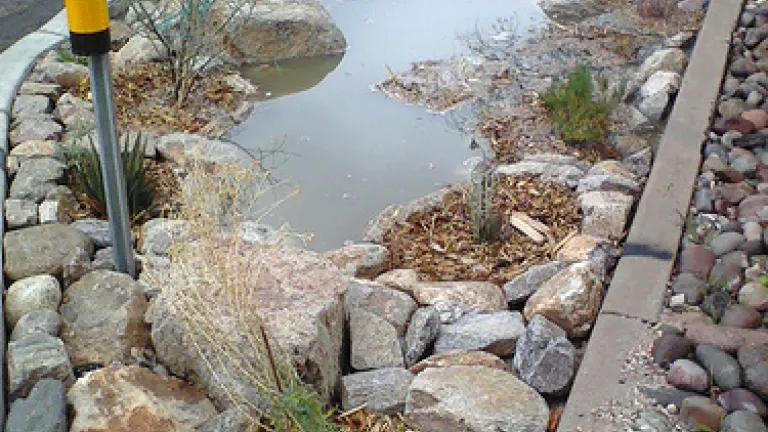
Arizona may be known for a lot of things, but rainfall is not one of them—it’s among the driest states in the country. However, having previously lived in the Grand Canyon State, I personally can attest to the fact that it does rain there. In fact, brief but heavy downpours during the summer monsoon season can cause flash flooding, threatening public safety and making roads impassable. Yet, during the rest of the year, rainfall is oftentimes scarce and water is a precious resource. That’s why it’s important for communities to take action to capture and use rainwater when it does fall.
Today, we’re happy to report that Tucson is the newest “Emerald City” profiled in NRDC’s most recent update of its report Rooftops to Rivers. Last updated in 2011, Rooftops to Rivers highlights cities that are using green infrastructure to solve their stormwater pollution and water scarcity problems. Today’s update reveals that in just the past two years, cities across the country have made significant progress in implementing their green infrastructure programs.
Water-harvesting and traffic-calming feature (known as a chicane) in the Dunbar Spring neighborhood of Tucson (photo credit: Steev Hise)
The phrase “green infrastructure” refers to a suite of techniques that mimic natural processes by capturing rainwater and beneficially managing it by storing it for use, evaporating it back to the atmosphere, or letting it filter into the ground, where it can benefit vegetation and replenish groundwater supplies. Examples of green infrastructure include green roofs, street trees, increased green space, rain barrels, rain gardens, and permeable pavement.
Not only does green infrastructure conserve and cleanse rainwater, it also has the added benefits of beautifying neighborhoods, cooling and cleaning the air, reducing asthma and heat-related illnesses, lowering heating and cooling energy costs, boosting economies, and supporting American jobs.
In Rooftops to Rivers, NRDC has identified six key actions that cities should take to maximize green infrastructure investment and become “Emerald Cities.” By taking two of those actions, Tucson has earned a spot on our list while making its water supplies more robust. Due to the city’s arid climate and average rainfall of only about 11 inches per year, the city necessarily views rainwater as a valuable resource, and it is using green infrastructure as a tool to harvest and conserve it.
First, Tucson implemented a requirement that all publicly funded roadway development and redevelopment projects integrate stormwater-harvesting features like vegetated basins. The city’s Green Streets policy also sets a standard of 25% tree canopy coverage on new roadways (up from the current city average of 5% canopy cover).
Second, Tucson increased incentives for private parties to use green infrastructure, specifically its rebate program for residential rainwater harvesting. The city will now rebate the costs of qualifying rainwater harvesting systems to a maximum of $2,000. The level of funding is based on the amount of water that applicants aim to capture and the types of practices that are implemented. Households that install a permanent gray water irrigation system can also apply for Tucson Water’s Single Family Residential Gray Water Rebate Program for reimbursements up to $1,000.
In addition to these activities already underway, in November 2013, Tucson will vote on replacing its 2001 General Plan with “Plan Tucson,” which includes a focus on green infrastructure.
These initiatives show that Tucson is well on its way to becoming a green infrastructure leader, helping to make life in the desert cleaner, healthier, and more sustainable.
